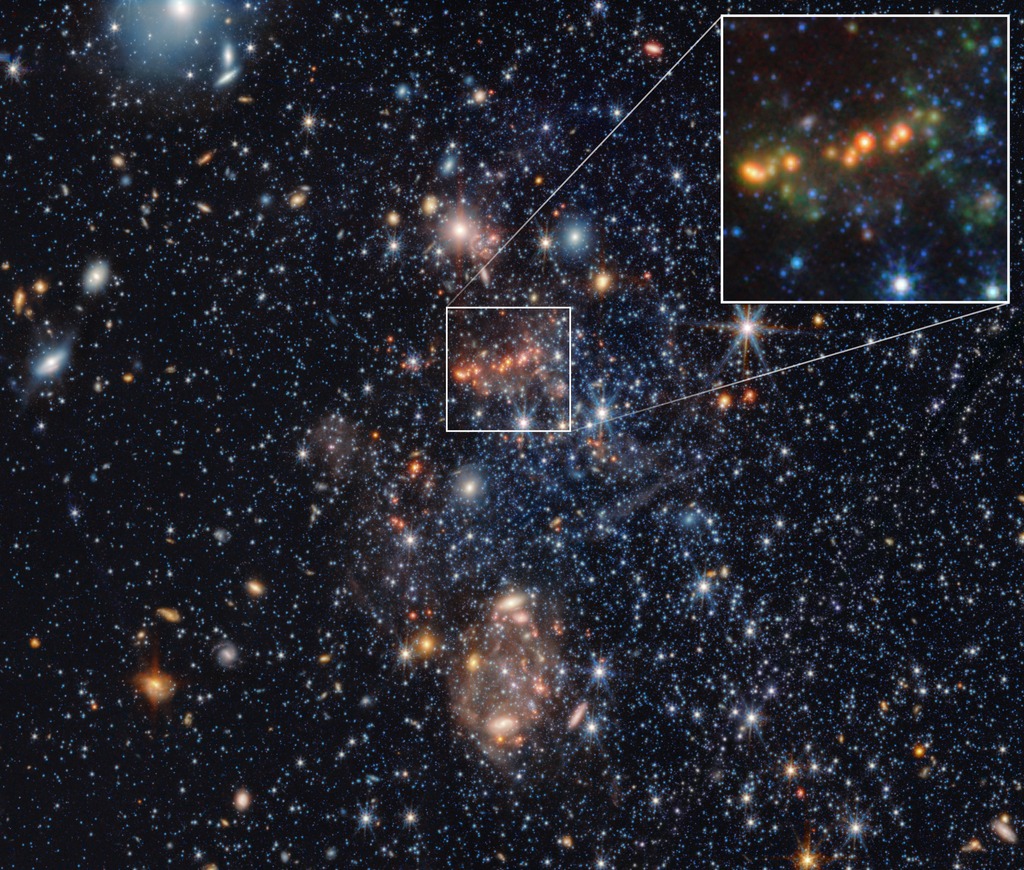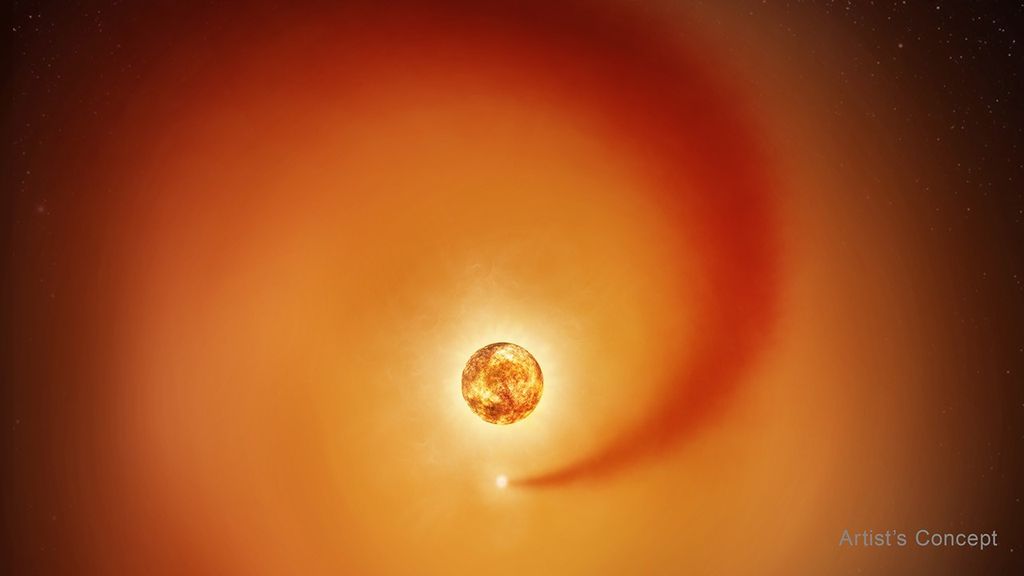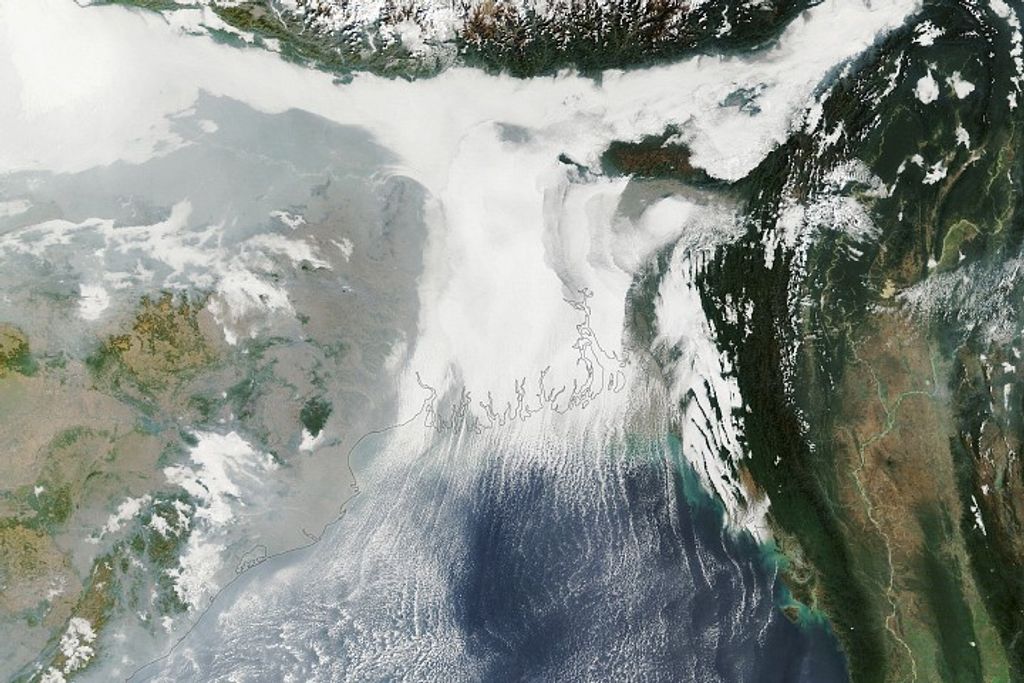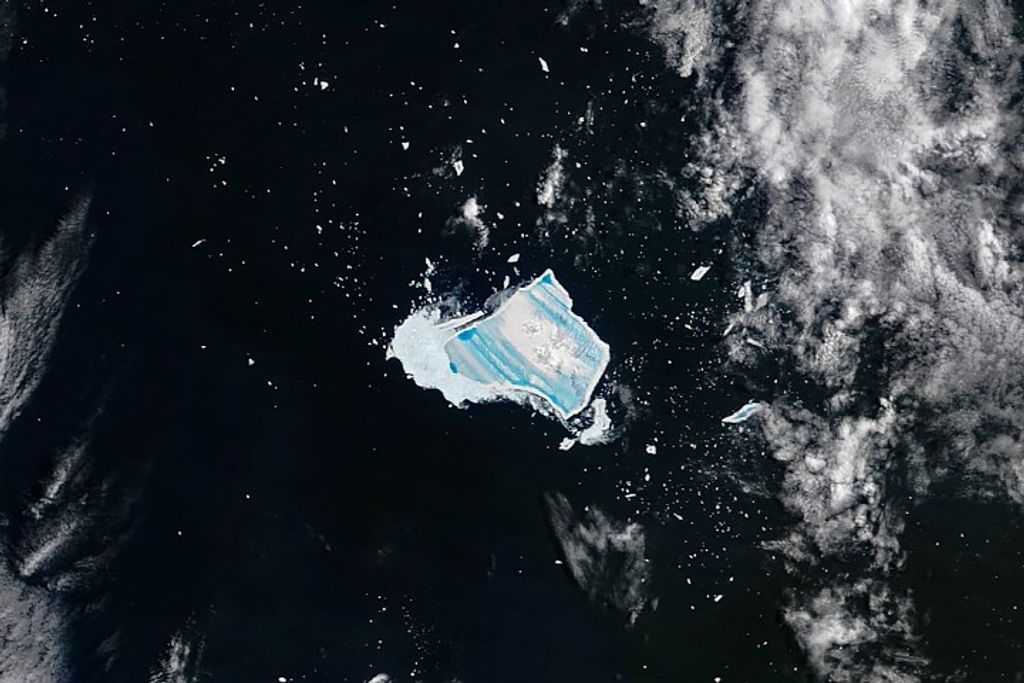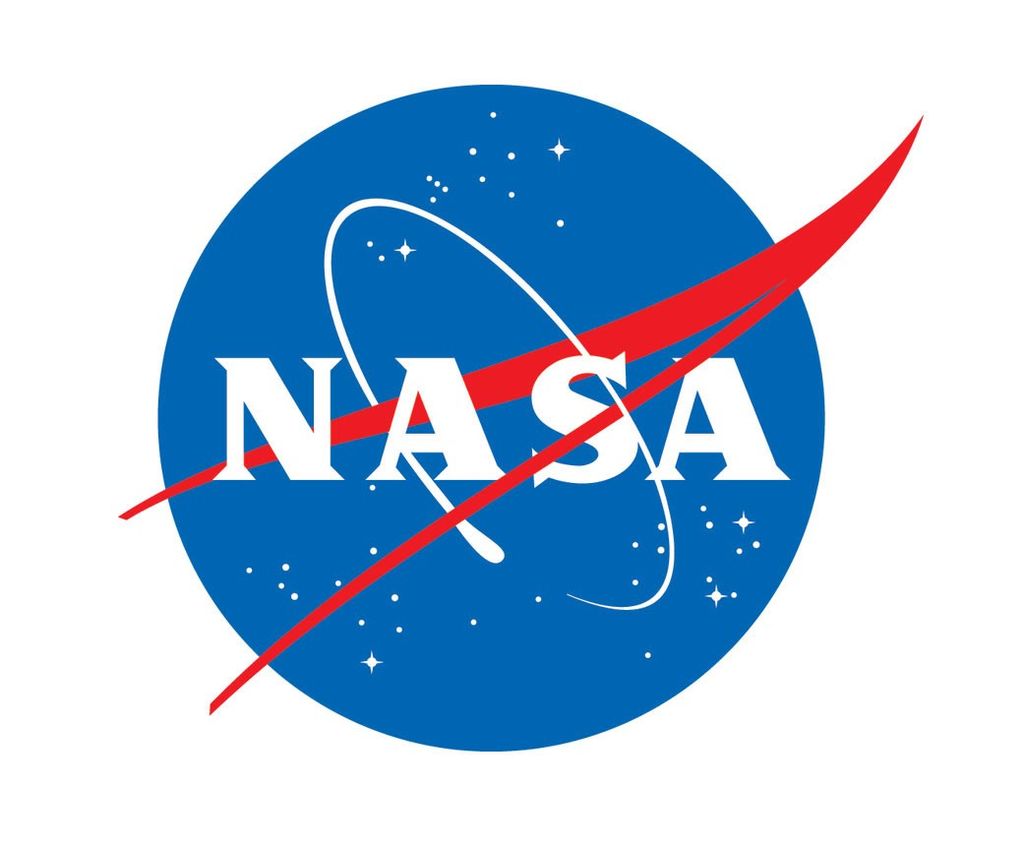1 min read
Webb and Hubble’s Views of Spiral Galaxy NGC 4535
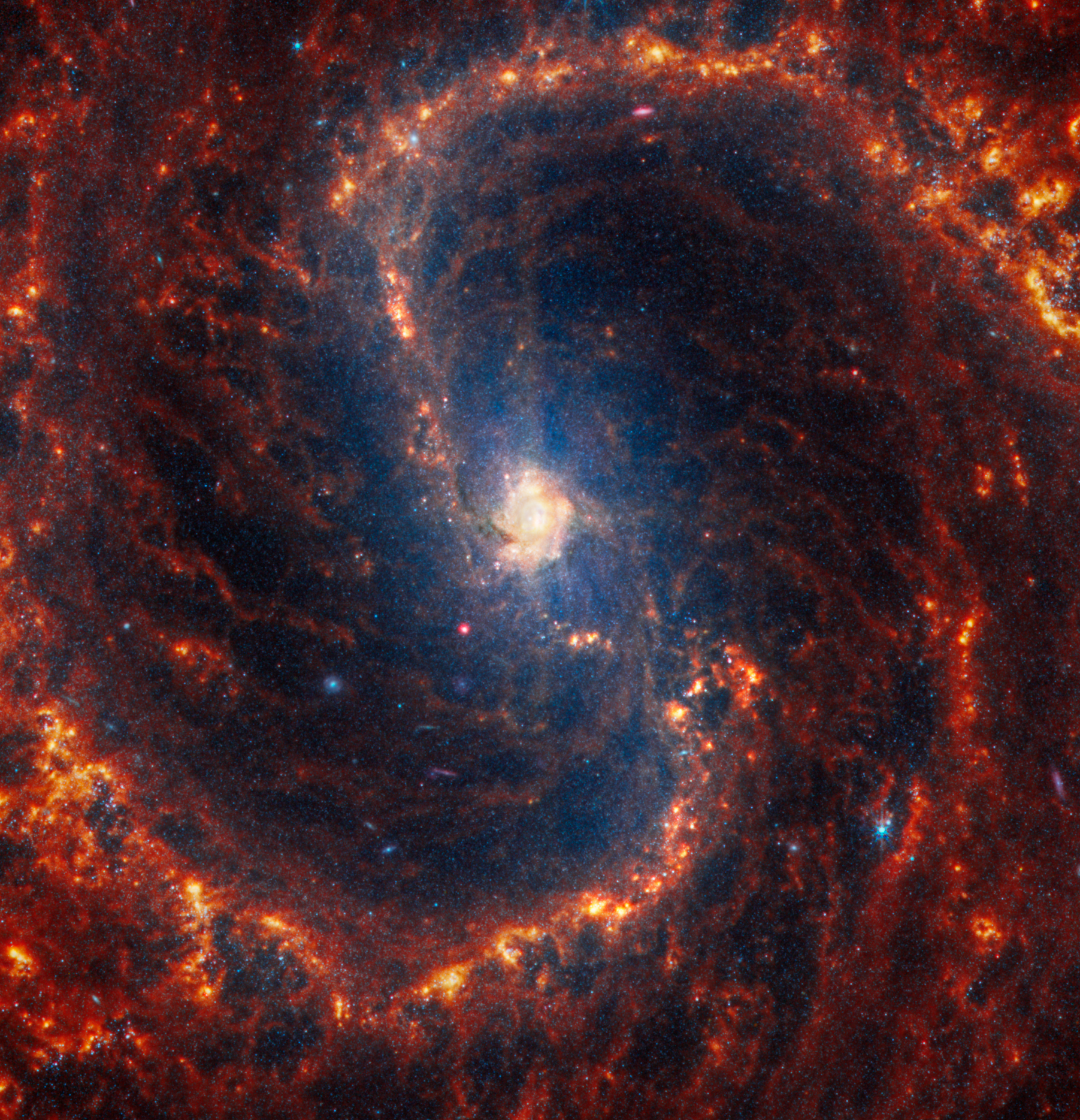
Face-on spiral galaxy, NGC 4535, is split diagonally in this image: The James Webb Space Telescope’s observations appear at bottom left, and the Hubble Space Telescope’s on top right. Webb and Hubble’s images show a striking contrast, an inverse of darkness and light. Why? Webb’s observations combine near- and mid-infrared light and Hubble’s showcase visible and ultraviolet light. Dust absorbs ultraviolet and visible light, and then re-emits it in the infrared. In Webb's images, we see dust glowing in infrared light. In Hubble’s images, dark regions are where starlight is absorbed by dust.
The individual Webb and Hubble images are available for download using the links on the left side of this page.
Color Decoder
Gas and Dust
In Webb’s high-resolution infrared images, the gas and dust stand out in stark shades of orange and red, and show finer spiral shapes with the appearance of jagged edges, though these areas are still diffuse.
In Hubble’s images, the gas and dust show up as hazy dark brown lanes, following the same spiral shapes. Its images are about the same resolution as Webb’s, but the gas and dust obscure a lot of the smaller-scale star formation.
Bright Central Spikes
Bright red diffraction spikes at a galaxy’s core in a Webb image can be a “calling card” of an active supermassive black hole, as seen in galaxy NGC 7496. Not all oversized diffraction spikes at galaxies’ cores are caused by black holes, though. Sometimes, they appear when a slew of very bright, centrally located star clusters are in the central region of Webb’s image.
In Hubble’s images, the galaxies’ cores are not as bright so these spikes are absent. Diffraction spikes only appear when the source is extremely bright and compact.
Older Stars
Sometimes, the central region in Webb’s image has a blue glow. This is a marker of high concentrations of older stars. Webb’s infrared observations allow us to see through the gas and dust to identify these older stars. The light these old stars emit are some of the shortest infrared wavelengths in Webb’s images, which is why they are assigned blue. (Read more about how color is precisely applied to Webb’s images.)
In comparison, the cores of Hubble’s image may appear yellower, washing the central region in a soft glow and fully obscuring individual points of light. Hazy brown dust lanes may also cover part of this area. In Hubble’s images, older stars are emitting some of the longest wavelengths of visible light Hubble captures, which is why the color assignments are different. (Compare the wavelengths of light Hubble and Webb observe.)
Younger Stars
In Webb’s image, the newly fully formed stars also appear blue along the galaxies’ spiral arms. Those blue stars have blown away the gas and dust that immediately surrounded them. The farther away they are from the core, the more likely stars are to be younger. Orange stars, likely seen in groups in these images, are even younger: They are still encased in their cocoons of gas and dust, allowing them to continue forming.
In Hubble’s images, younger stars pop out in blue and purple – and appear almost everywhere. In contrast, the older stars near the center of the galaxy appear yellowish.
Star-Forming Regions
Look for knots of bright red and orange in Webb’s image. These are especially easy to identify toward the outer edges of the galaxy’s spiral arms. These are regions of star formation, and mid-infrared light highlights the gas and dust that are a huge part of the mix, since they are primary ingredients for stars that are actively forming.
In Hubble’s images, star-forming regions are clusters of bright blue and purple, or sometimes red and pink as hot stars energize nearby hydrogen gas.
Background Galaxies
Webb’s image includes distant galaxies that are located well behind the tightly cropped foreground galaxy. Look for bright blue and pink disks, some seen edge-on, like a plate with a central sphere. Redder galaxies are more distant.
In Hubble’s view, distant galaxies are often light orange if they are slightly closer. Like in Webb's image, those that are deeper red are also more distant.
Galaxy NGC 4535 was observed as part of the Physics at High Angular resolution in Nearby GalaxieS (PHANGS) program, a large project that includes observations from several space- and ground-based telescopes of many galaxies to help researchers study all phases of the star formation cycle, from the formation of stars within dusty gas clouds to the energy released in the process that creates the intricate structures revealed by Webb’s new images.
NGC 4535 is 50 million light-years away in the constellation Virgo.
Extended Description and Image Alt Text
Extended Description
Webb’s complete image
Webb’s image of NGC 4535 shows a densely populated face-on barred spiral galaxy anchored by its small central region, which has a light orange haze. Toward the center, the bar structure is filled with a blue haze of stars that forms a roughly vertical oval shape that stretches across most of the frame. Filaments of glowing dust cross the bar and are connected to two prominent spiral arms made of stars, gas, and dust. These structures start at the center, creating line-like arcs that go from the top and curve around to the right, and from the bottom right in an arc that curves up to the top left, forming an elongated S shape. The spiral arms rotate clockwise and are largely orange, ranging from dark to bright orange, brightest at the edges. Scattered across the packed scene are some additional bright blue pinpoints of light, which are stars and star clusters spread throughout the galaxy. In the darker areas, it’s easier to spot brighter larger pinpoints of light. Some of these are blue and some are pink. A few appear more like ovals at the edges.
Hubble’s complete image
Hubble’s image of NGC 4535 shows a densely populated face-on barred spiral galaxy anchored by its central region, which begins as a small yellow dot. The galaxy’s bar extends as a yellow haze from there, forming a roughly vertical shape at the center that stretches across most of the frame. Two prominent spiral arms made of stars, gas, and dust connect to the bar, creating thin arcs that start from the top and around to the right, and in an arc that curves from the bottom right up and to the left, forming an elongated S shape. The spiral arms rotate clockwise and are made of dark brown, filamentary dust lanes and bright blue star clusters, brightest at the edges. There are prominent orange dots toward the bottom left and top center, and a bright, larger foreground star with four diffraction spikes at bottom right. Tiny black triangles at bottom left, top right, and bottom right corners reflect where there is no data.
Image Alt Text
Webb’s image of NGC 4535 shows a densely populated face-on barred spiral galaxy anchored by its central region, which has a light orange haze. The galaxy’s core is centered and connected by an almost vertical bar structure to the galaxy’s two prominent spiral arms, which appear to rotate clockwise, forming an elongated S shape in shades of orange.
About the Object
- R.A. PositionR.A. PositionRight ascension – analogous to longitude – is one component of an object's position.12:34:20.17
- Dec. PositionDec. PositionDeclination – analogous to latitude – is one component of an object's position.08:12:4.76
- ConstellationConstellationOne of 88 recognized regions of the celestial sphere in which the object appears.Virgo
- DistanceDistanceThe physical distance from Earth to the astronomical object. Distances within our solar system are usually measured in Astronomical Units (AU). Distances between stars are usually measured in light-years. Interstellar distances can also be measured in parsecs.About 50 million light-years away
About the Data
- Data DescriptionData DescriptionProposal: A description of the observations, their scientific justification, and the links to the data available in the science archive.
Science Team: The astronomers who planned the observations and analyzed the data. "PI" refers to the Principal Investigator.The Webb image was created with data from proposal: 2107 (J. Lee). Image Processing: Joseph DePasquale (STScI).
- InstrumentInstrumentThe science instrument used to produce the data.Webb> NIRCam, MIRI Hubble> WFC3/UVIS
- FiltersFiltersThe camera filters that were used in the science observations.Webb> F300M, F335M, F360M, F770W, F1000W, F1130W, F2100W Hubble> F275W, F336W, F438W, F555W, F814W
- Object NameObject NameA name or catalog number that astronomers use to identify an astronomical object.NGC 4535
- Object DescriptionObject DescriptionThe type of astronomical object.Barred spiral galaxy
- Release DateJanuary 29, 2024
- Science ReleaseNASA’s Webb Depicts Staggering Structure in 19 Nearby Spiral Galaxies
- CreditImage: NASA, ESA, CSA, STScI, PHANGS Team, Janice Lee (STScI), Thomas Williams (Oxford)
Downloads

Webb Image: This image is a composite of separate exposures acquired by the James Webb Space Telescope using the NIRCam and MIRI instruments. Several filters were used to sample specific wavelength ranges. The color results from assigning different hues (colors) to each monochromatic (grayscale) image associated with an individual filter. In this case, the assigned colors are: Red = F2100W + F1130W + F1000W + F770WGreen = F770W + F360MBlue = F335M + F300M Hubble Image: This image is a composite of separate exposures acquired by the Hubble Space Telescope using the WFC3/UVIS instrument. Several filters were used to sample specific wavelength ranges. The color results from assigning different hues (colors) to each monochromatic (grayscale) image associated with an individual filter. In this case, the assigned colors are: Red= F814W Green = F555W Blue = F438W Blue = F336W Purple = F275W
Related Images & Videos
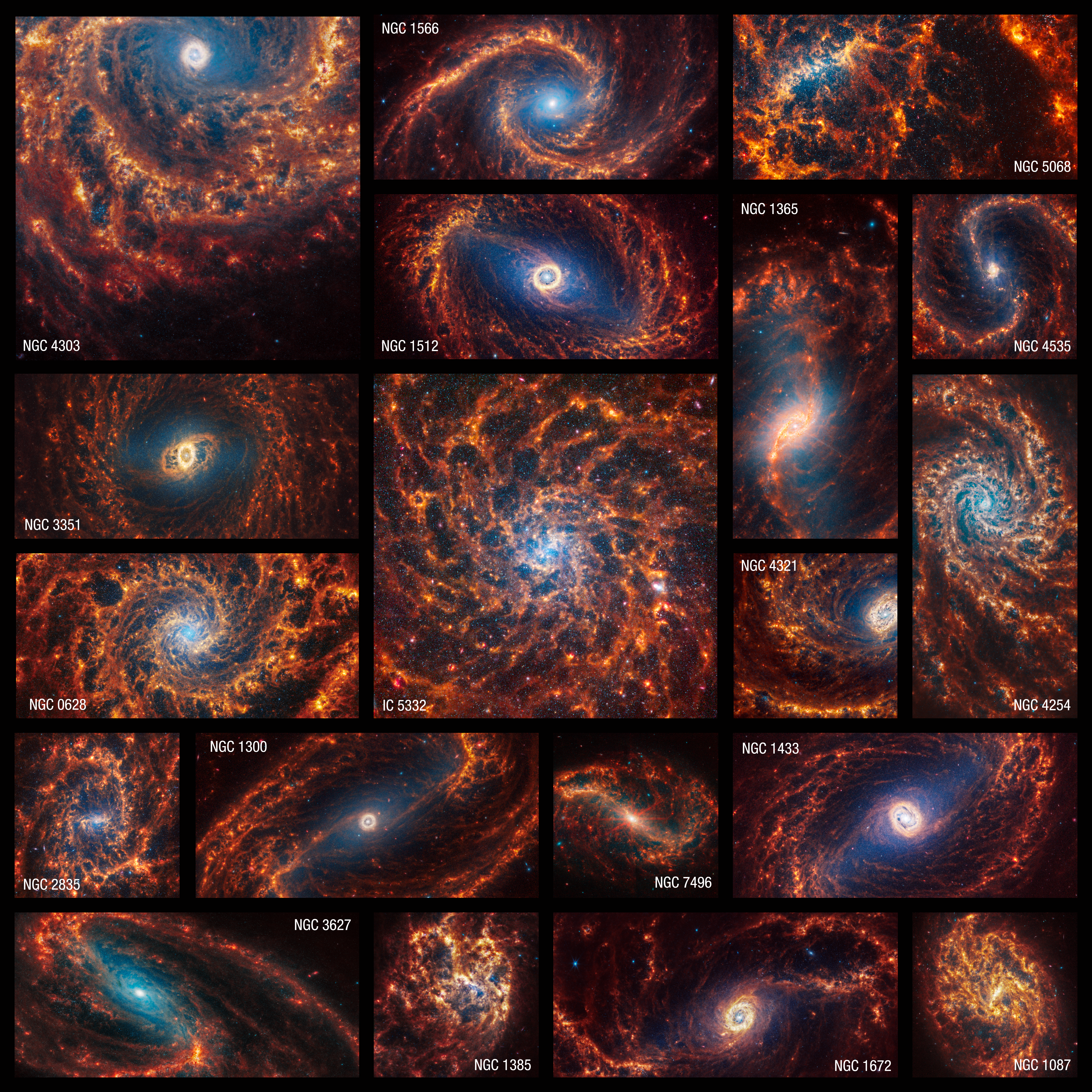
Webb's Stunning Collection of 19 Face-On Spiral Galaxies
This collection of 19 face-on spiral galaxies from the James Webb Space Telescope in near- and mid-infrared light is at once overwhelming and awe-inspiring. “Webb’s new images are extraordinary,” said Janice Lee, a project scientist for strategic initiatives at the Space...
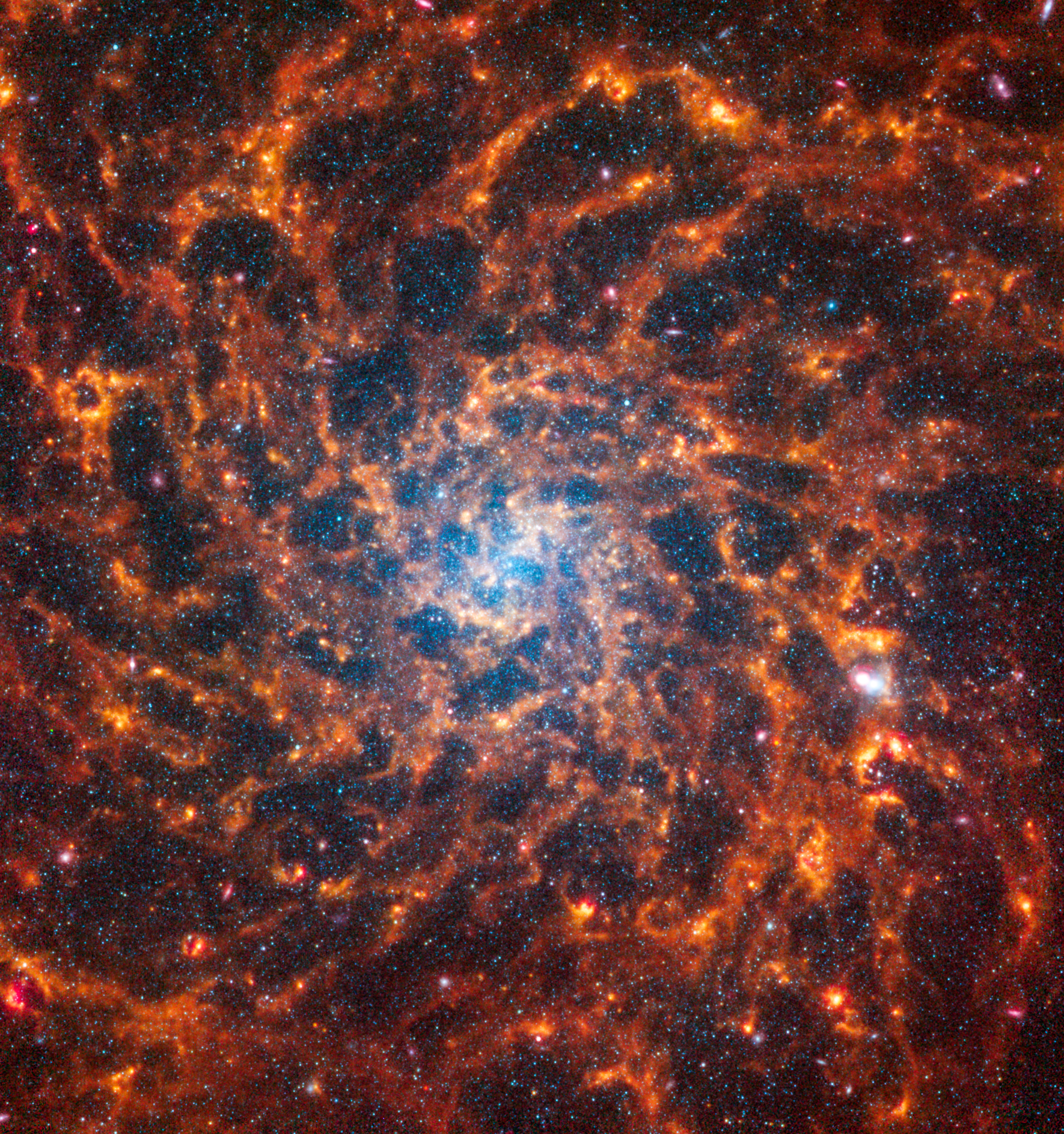
Webb and Hubble's Views of Spiral Galaxy IC 5332
Face-on spiral galaxy, IC 5332, is split diagonally in this image: The James Webb Space Telescope’s observations appear at top left, and the Hubble Space Telescope’s at bottom right. Webb and Hubble’s images show a striking contrast, an inverse of darkness and light. Why? Webb’s...
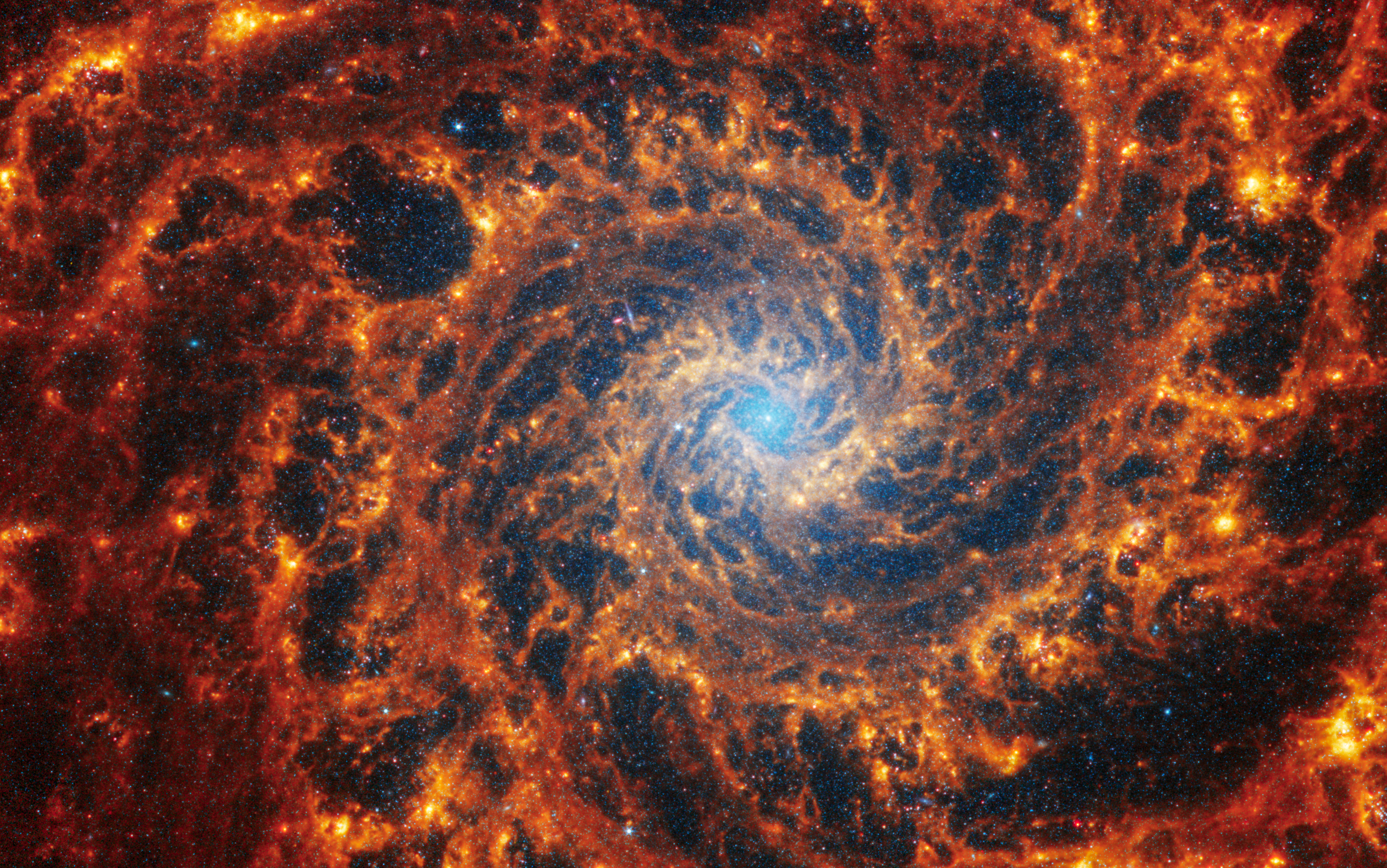
Webb and Hubble's Views of Spiral Galaxy NGC 628
Face-on spiral galaxy, NGC 628, is split diagonally in this image: The James Webb Space Telescope’s observations appear at top left, and the Hubble Space Telescope’s on bottom right. Webb and Hubble’s images show a striking contrast, an inverse of darkness and light. Why? Webb’s...
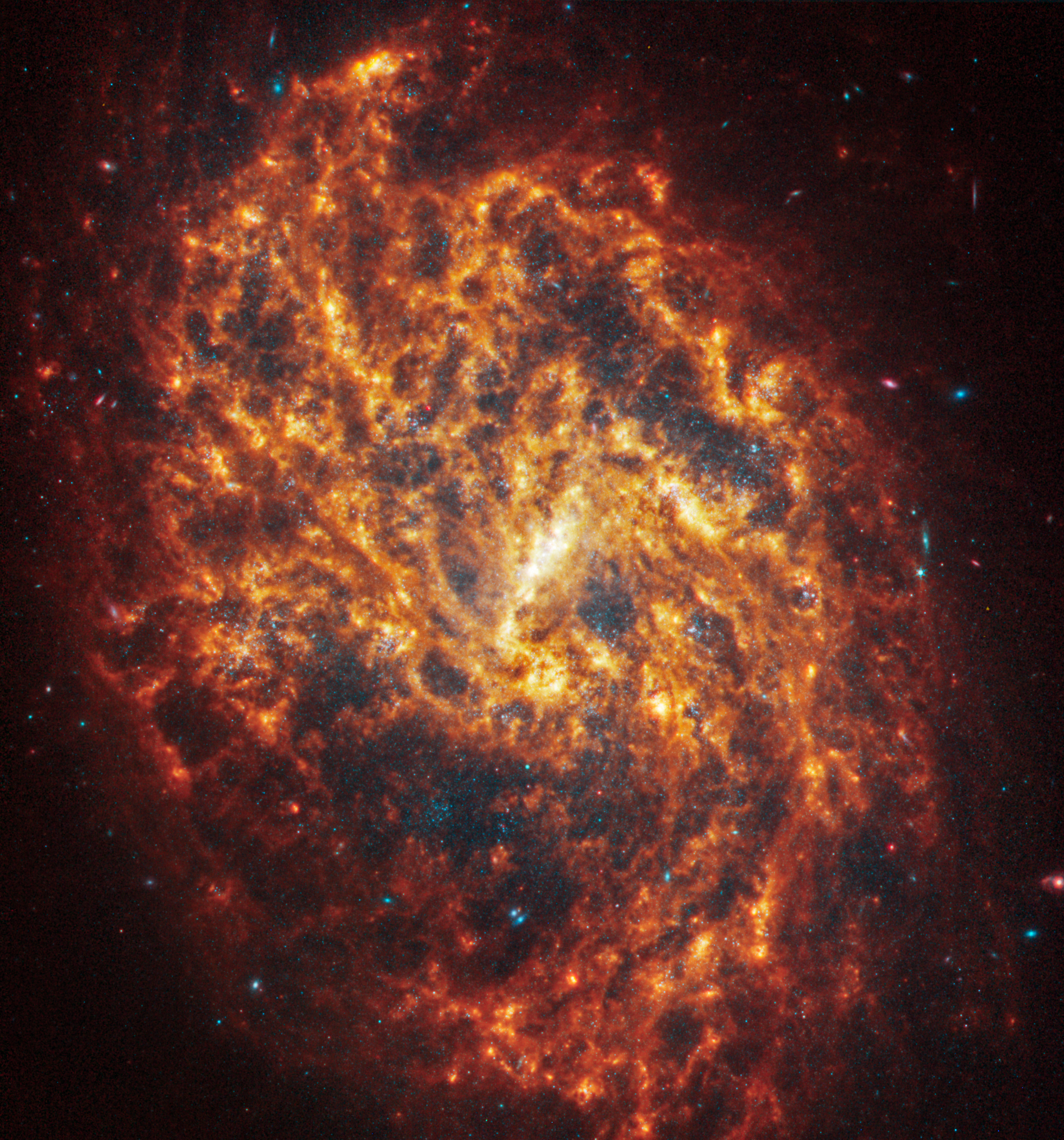
Webb and Hubble's Views of Spiral Galaxy NGC 1087
Face-on spiral galaxy, NGC 1087, is split diagonally in this image: The James Webb Space Telescope’s observations appear at top left, and the Hubble Space Telescope’s on bottom right. Webb and Hubble’s images show a striking contrast, an inverse of darkness and light. Why?...
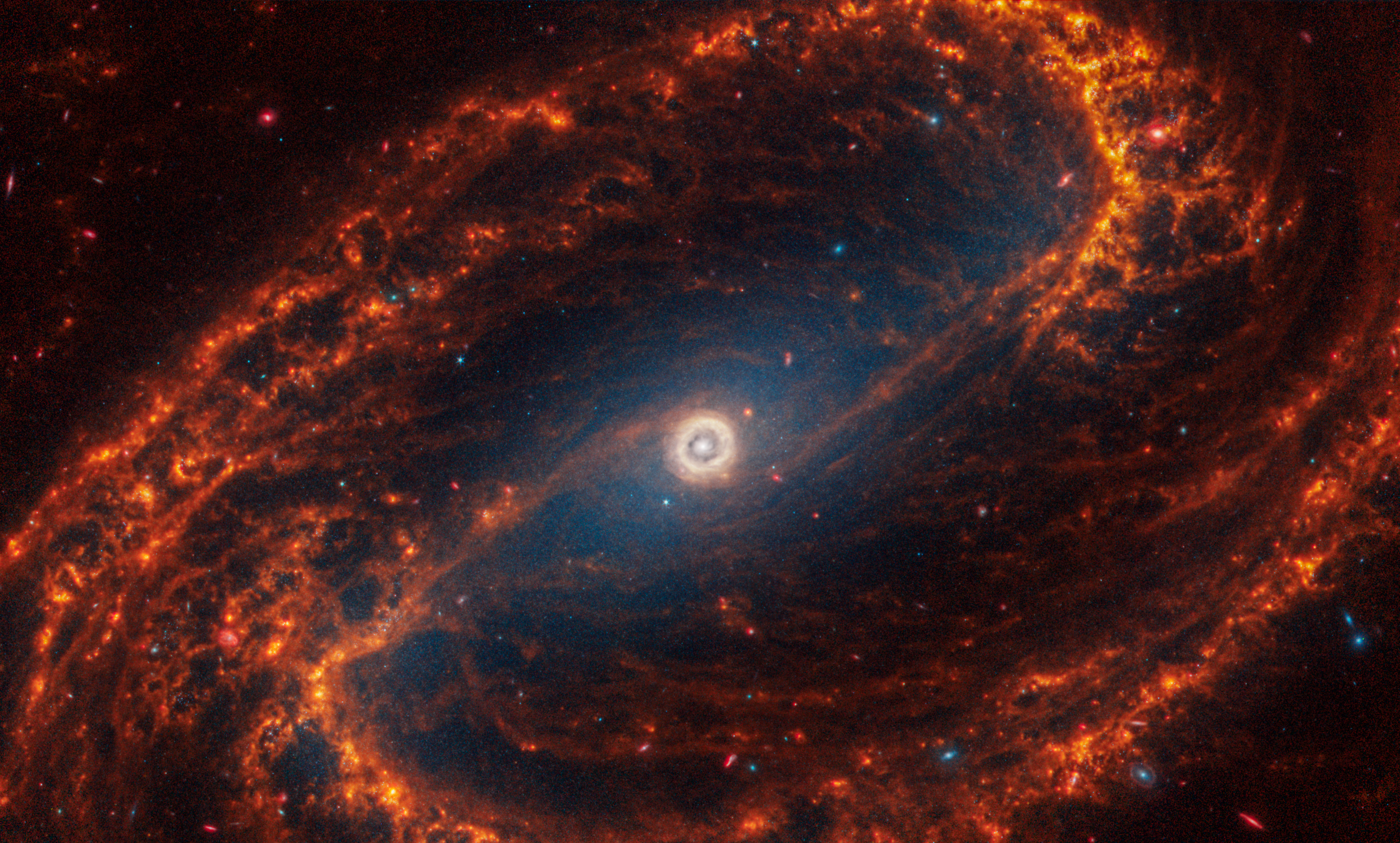
Webb and Hubble's Views of Spiral Galaxy NGC 1300
Face-on barred spiral galaxy, NGC 1300, is split diagonally in this image: The James Webb Space Telescope’s observations appear at top left, and the Hubble Space Telescope’s on bottom right. Webb and Hubble’s images show a striking contrast, an inverse of darkness and light....
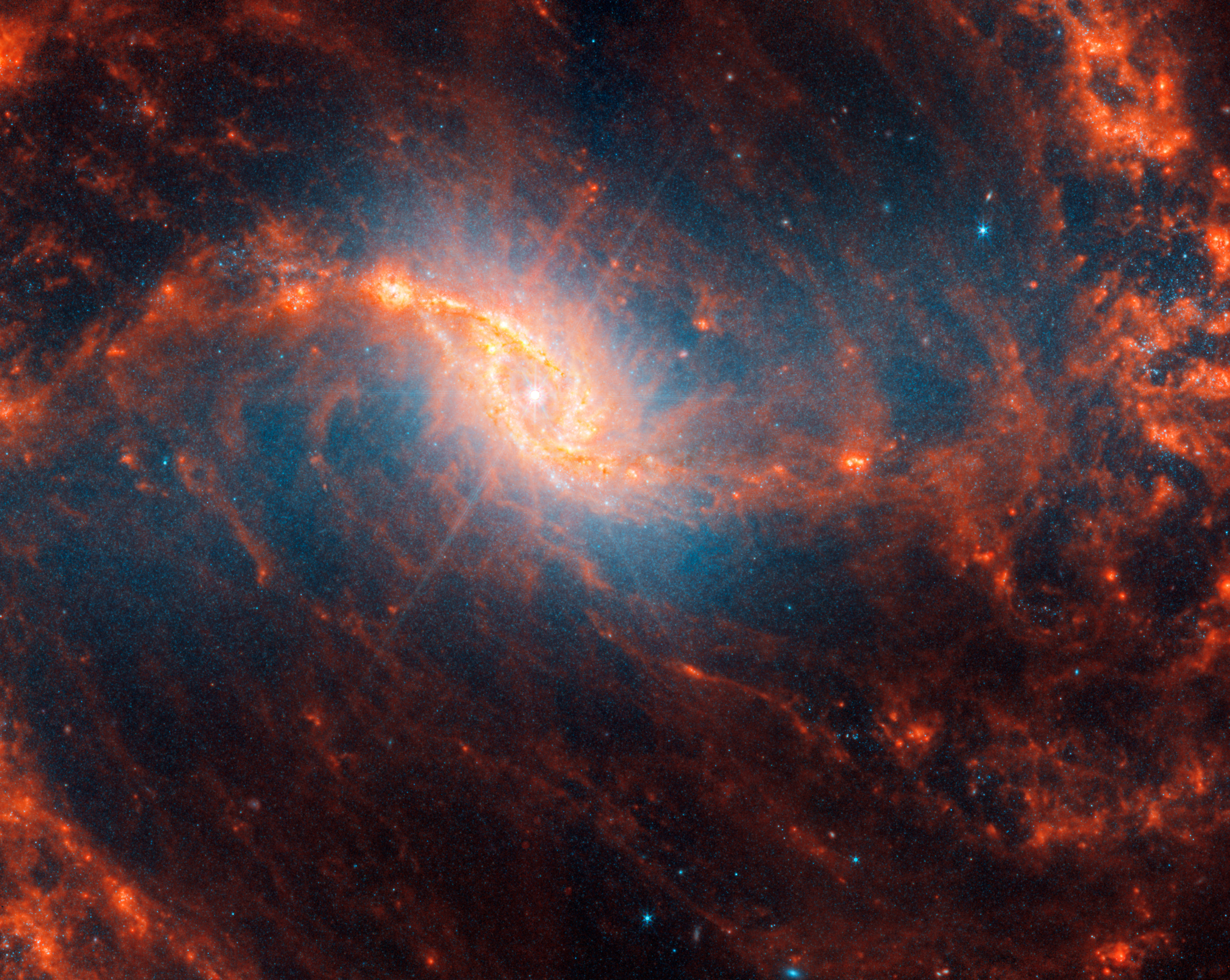
Webb and Hubble's Views of Spiral Galaxy NGC 1365
Barred spiral galaxy, NGC 1365, is split diagonally in this image: The James Webb Space Telescope’s observations appear on bottom right, and the Hubble Space Telescope’s at top left. Webb and Hubble’s images show a striking contrast, an inverse of darkness and light. Why? Webb’s...

Webb and Hubble's Views of Spiral Galaxy NGC 1385
Face-on spiral galaxy, NGC 1385, is split diagonally in this image: The James Webb Space Telescope’s observations appear at top left, and the Hubble Space Telescope’s on bottom right. Webb and Hubble’s images show a striking contrast, an inverse of darkness and light. Why?...
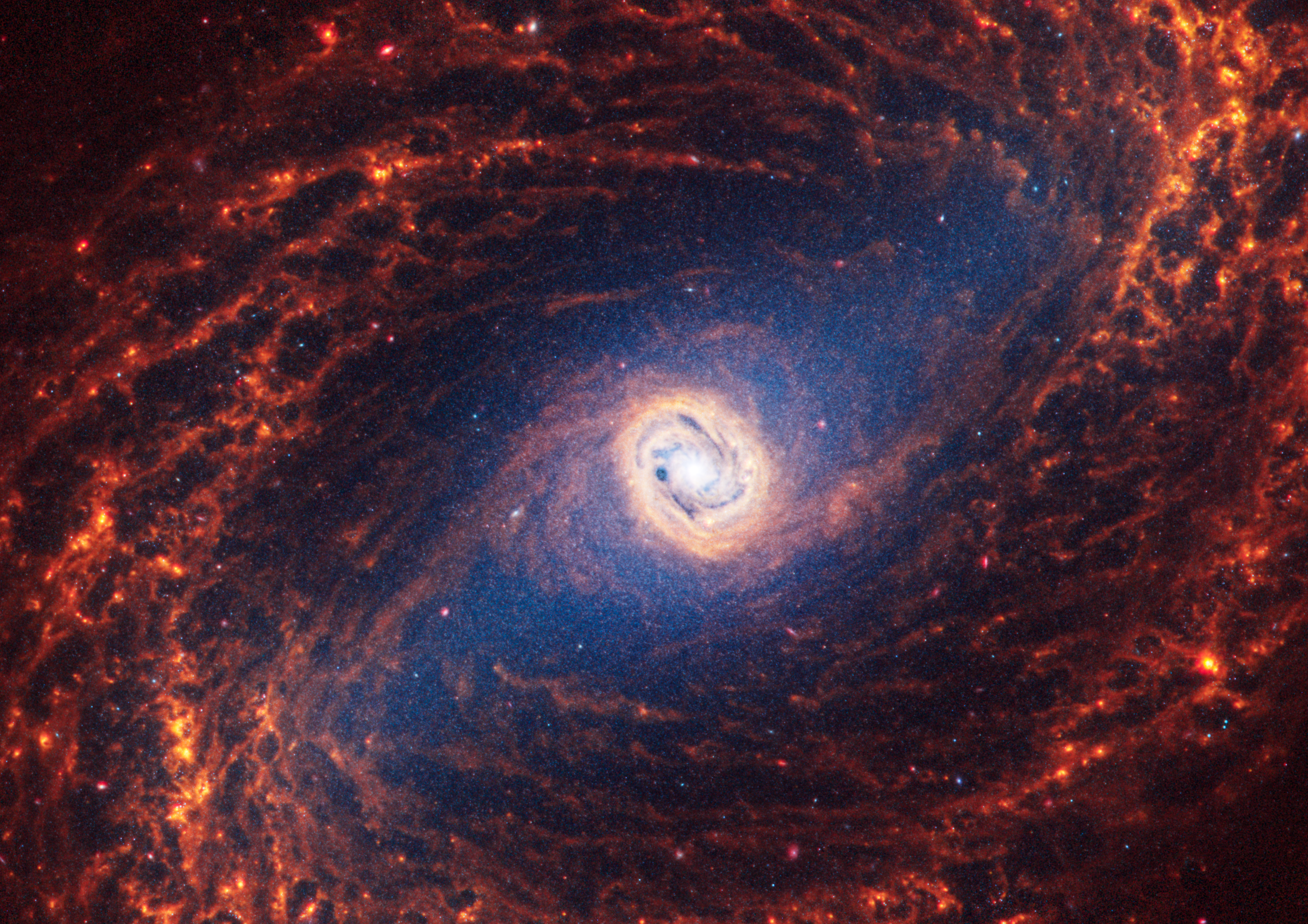
Webb and Hubble's Views of Spiral Galaxy NGC 1433
Face-on barred spiral galaxy, NGC 1433, is split diagonally in this image: The James Webb Space Telescope’s observations appear at top left, and the Hubble Space Telescope’s on bottom right. Webb and Hubble’s images show a striking contrast, an inverse of darkness and light....
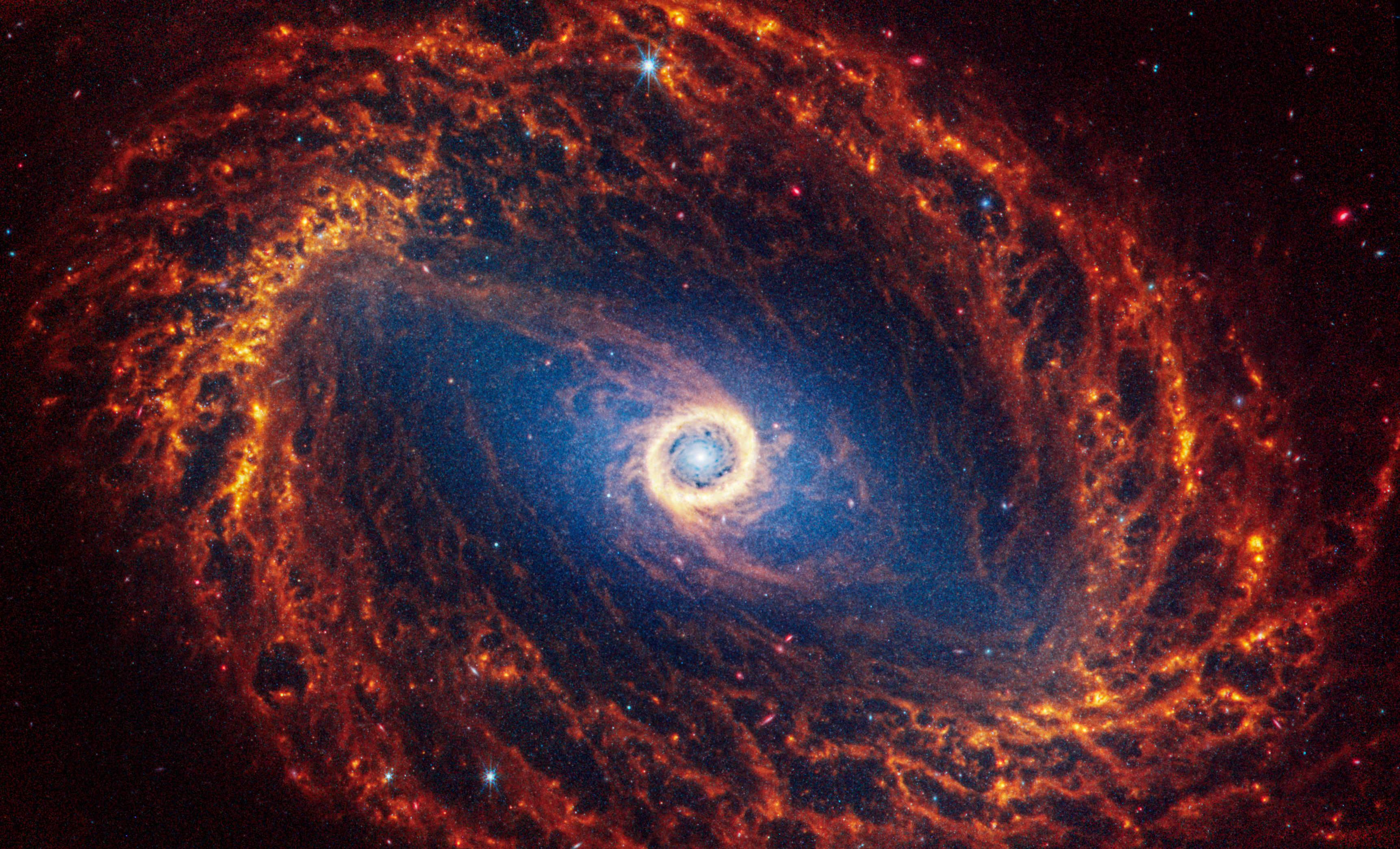
Webb and Hubble's Views of Spiral Galaxy NGC 1512
Face-on barred spiral galaxy, NGC 1512, is split diagonally in this image: The James Webb Space Telescope’s observations appear at top left, and the Hubble Space Telescope’s on bottom right. Webb and Hubble’s images show a striking contrast, an inverse of darkness and light....
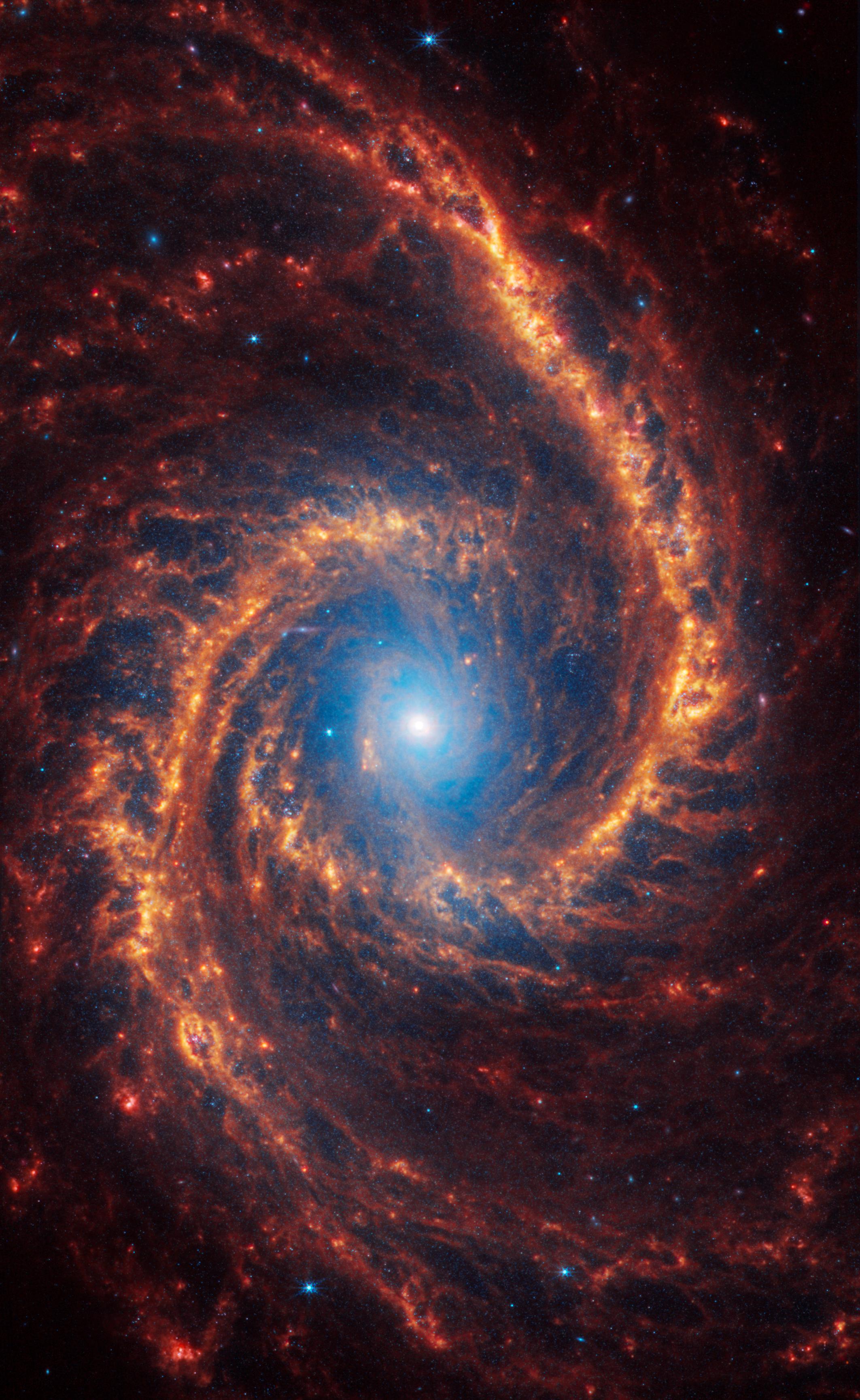
Webb and Hubble's Views of Spiral Galaxy NGC 1566
Face-on spiral galaxy, NGC 1566, is split diagonally in this image: The James Webb Space Telescope’s observations appear on bottom right, and the Hubble Space Telescope’s at top left. Webb and Hubble’s images show a striking contrast, an inverse of darkness and light. Why?...
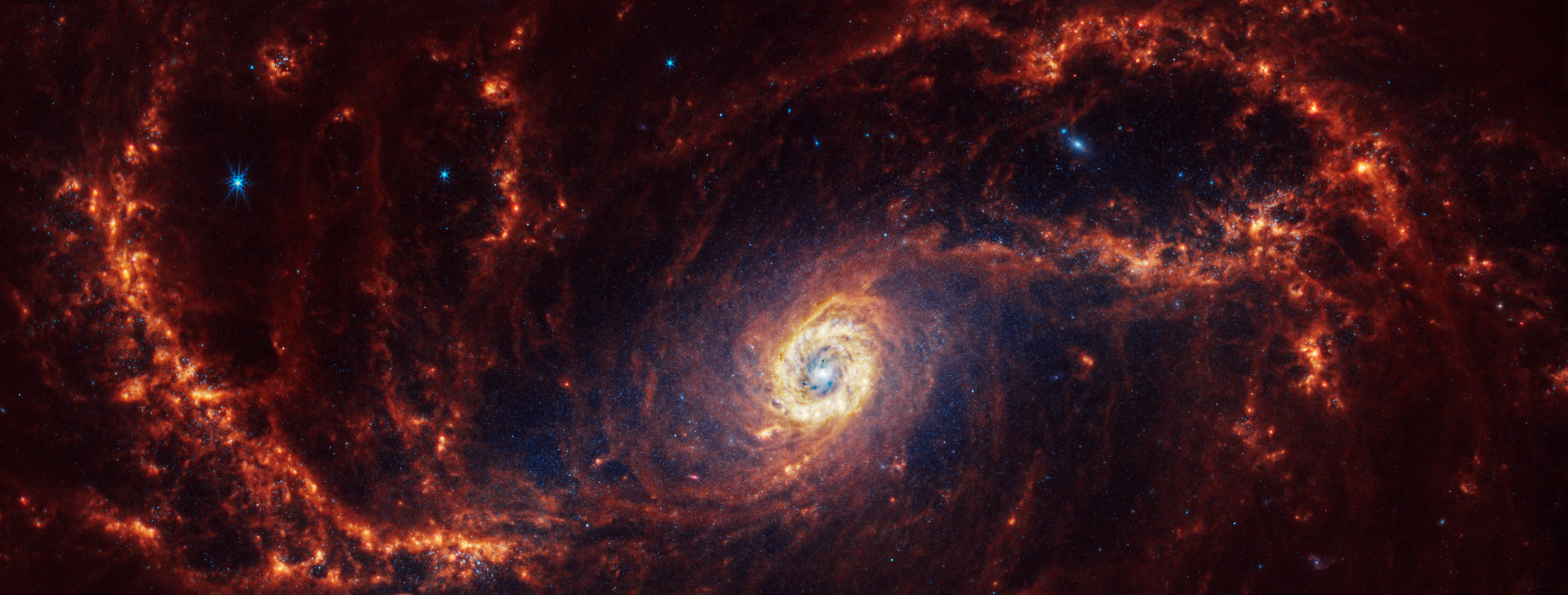
Webb and Hubble's Views of Spiral Galaxy NGC 1672
Face-on spiral galaxy, NGC 1672, is split diagonally in this image: The James Webb Space Telescope’s observations appear on bottom right, and the Hubble Space Telescope’s at top left. Webb and Hubble’s images show a striking contrast, an inverse of darkness and light. Why?...
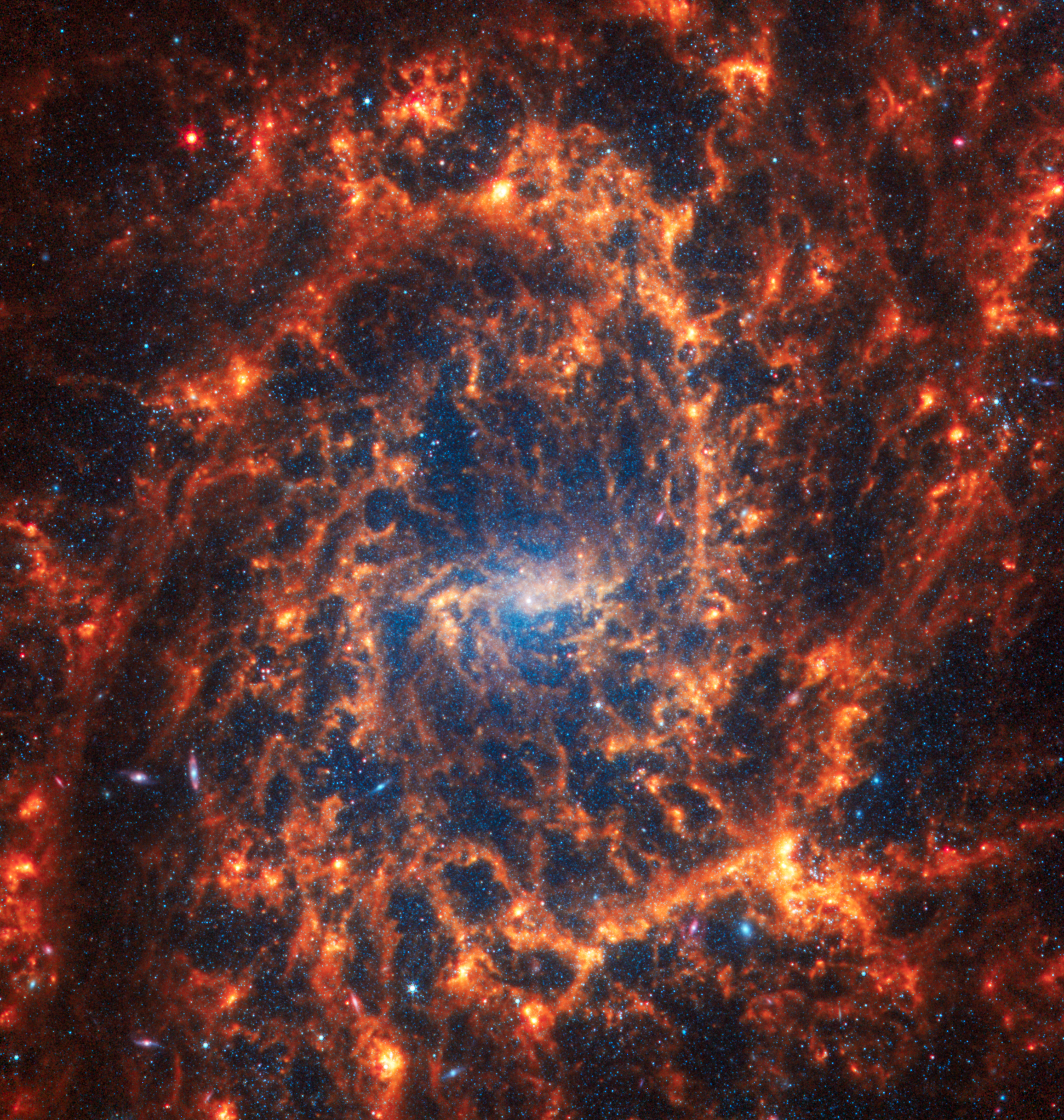
Webb and Hubble's Views of Spiral Galaxy NGC 2835
Face-on spiral galaxy, NGC 2835, is split diagonally in this image: The James Webb Space Telescope’s observations appear at top left, and the Hubble Space Telescope’s on bottom right. Webb and Hubble’s images show a striking contrast, an inverse of darkness and light. Why?...
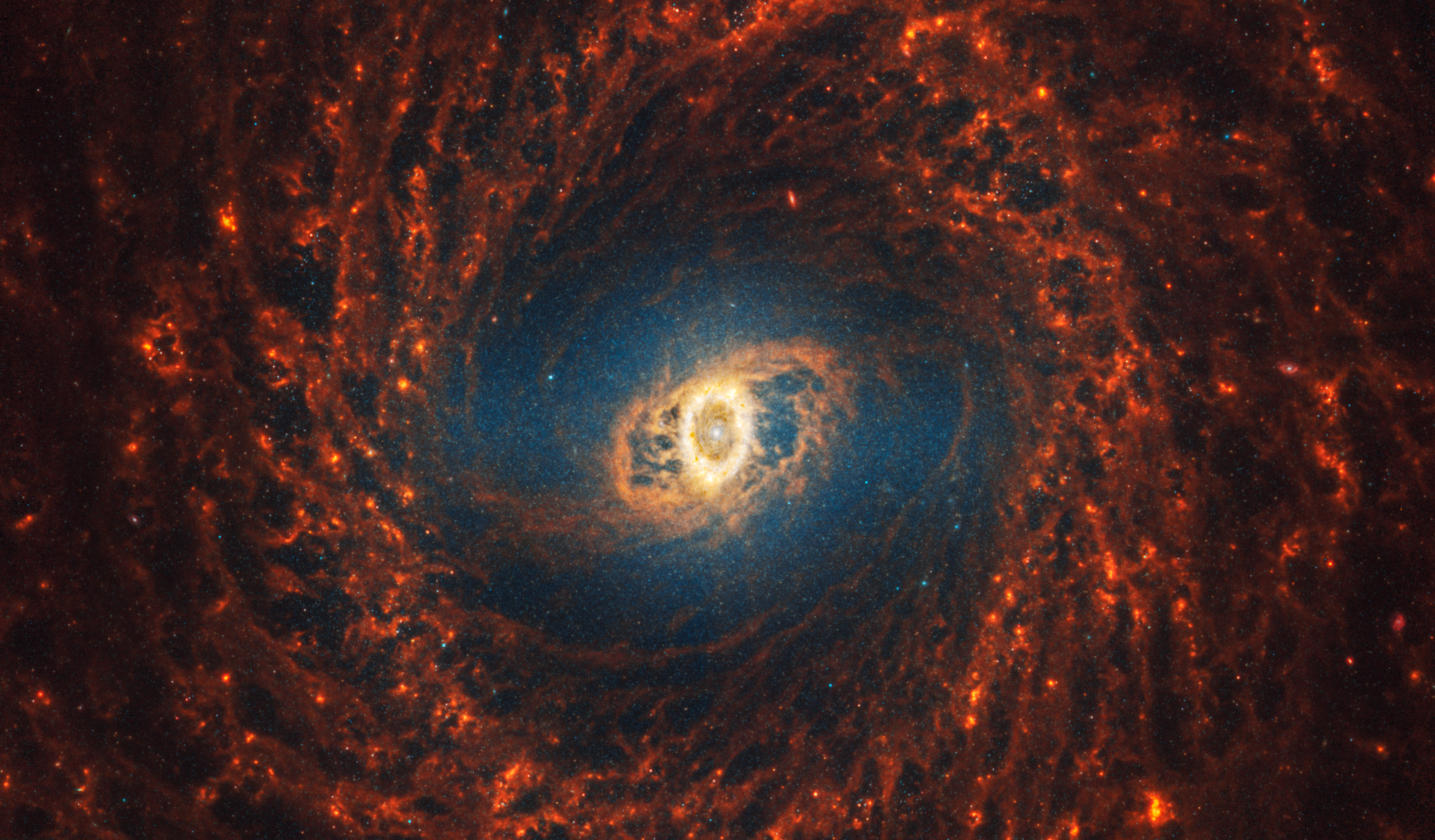
Webb and Hubble's Views of Spiral Galaxy NGC 3351
Face-on spiral galaxy, NGC 3351, is split diagonally in this image: The James Webb Space Telescope’s observations appear on bottom right, and the Hubble Space Telescope’s at top left. Webb and Hubble’s images show a striking contrast, an inverse of darkness and light. Why?...
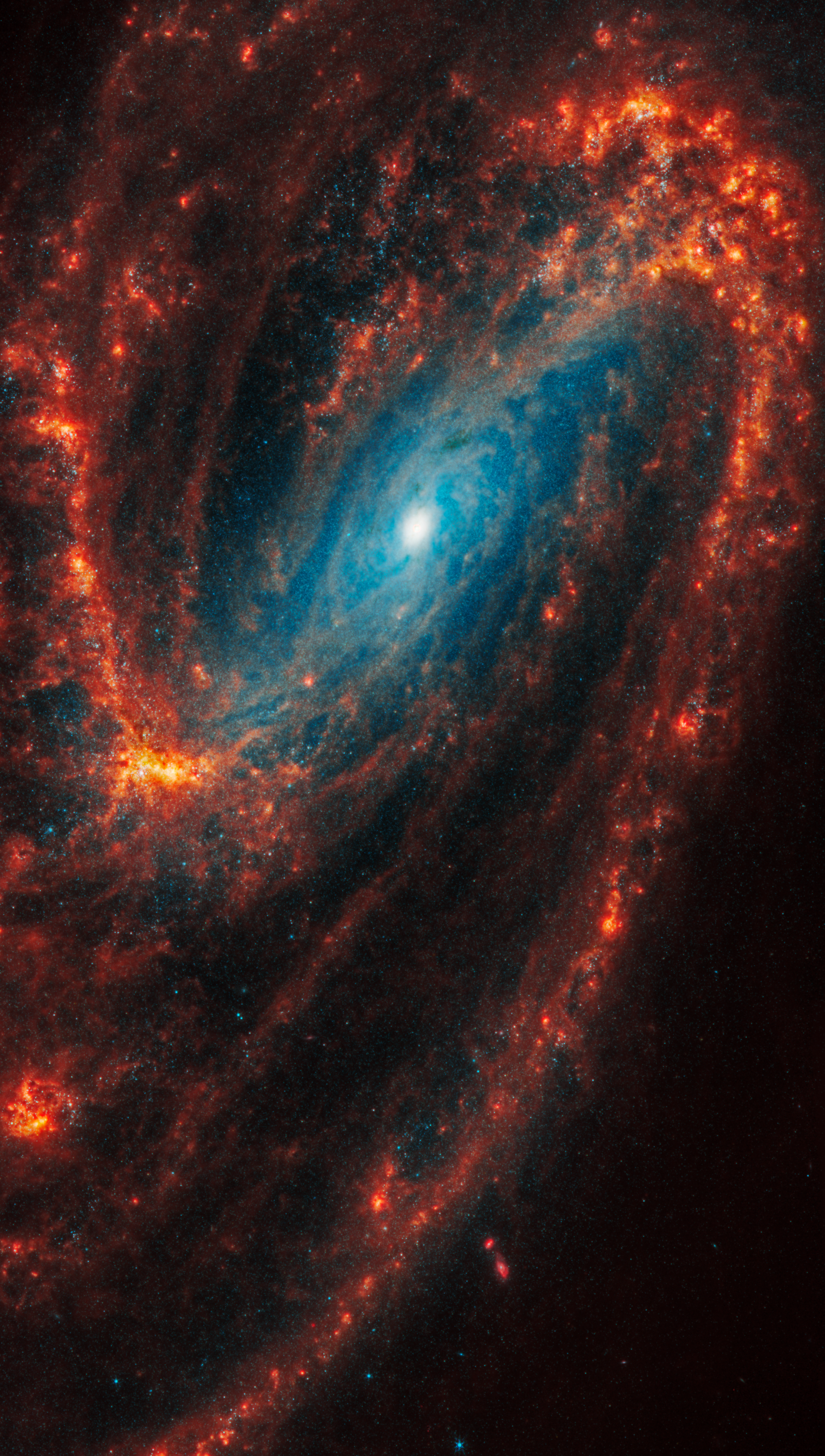
Webb and Hubble's Views of Spiral Galaxy NGC 3627
Face-on spiral galaxy, NGC 3627, is split diagonally in this image: The James Webb Space Telescope’s observations appear on bottom right, and the Hubble Space Telescope’s at top left. Webb and Hubble’s images show a striking contrast, an inverse of darkness and light. Why?...
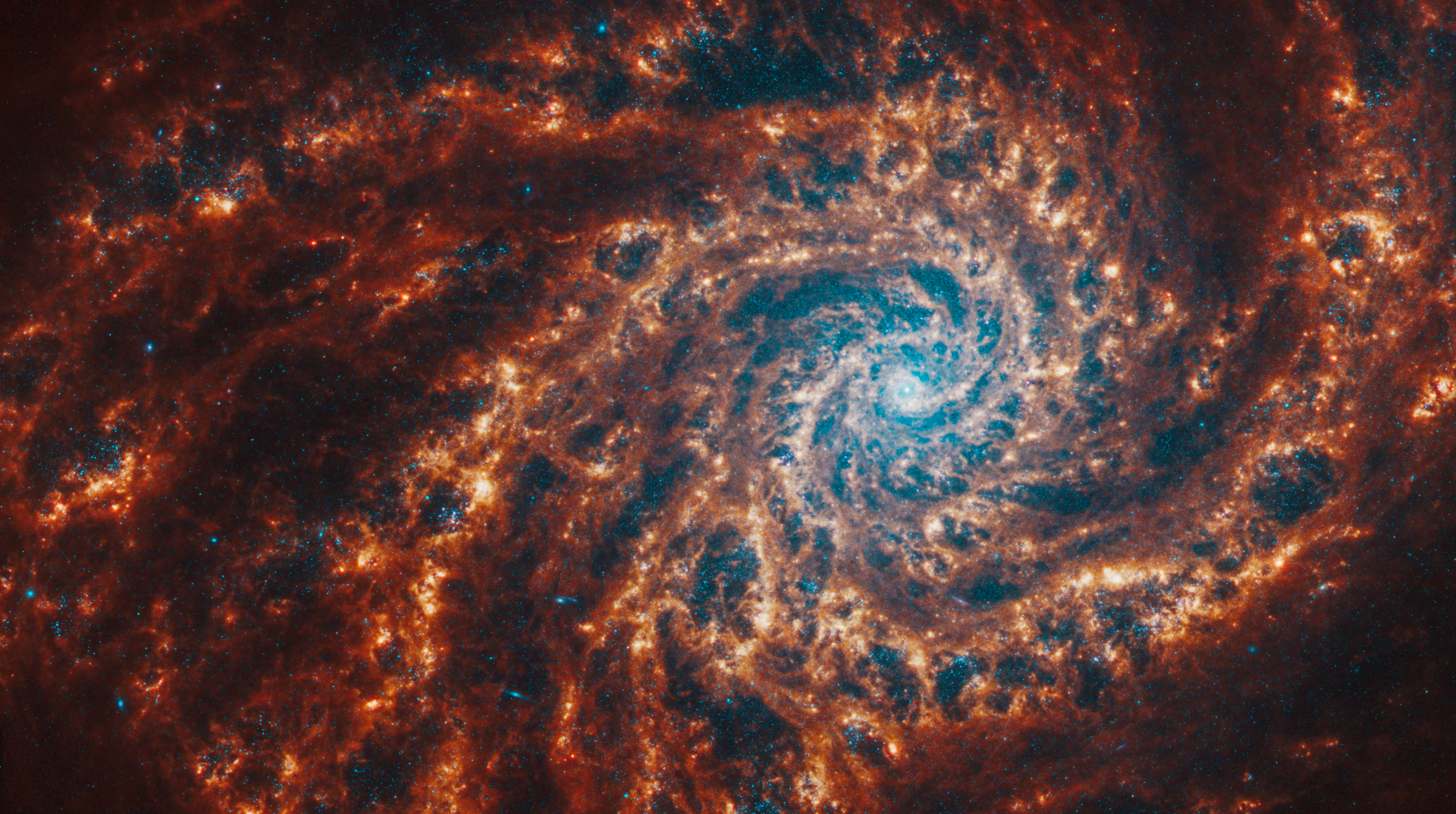
Webb and Hubble's Views of Spiral Galaxy NGC 4254
Face-on spiral galaxy, NGC 4254, is split diagonally in this image: The James Webb Space Telescope’s observations appear at top left, and the Hubble Space Telescope’s on bottom right. Webb and Hubble’s images show a striking contrast, an inverse of darkness and light. Why?...
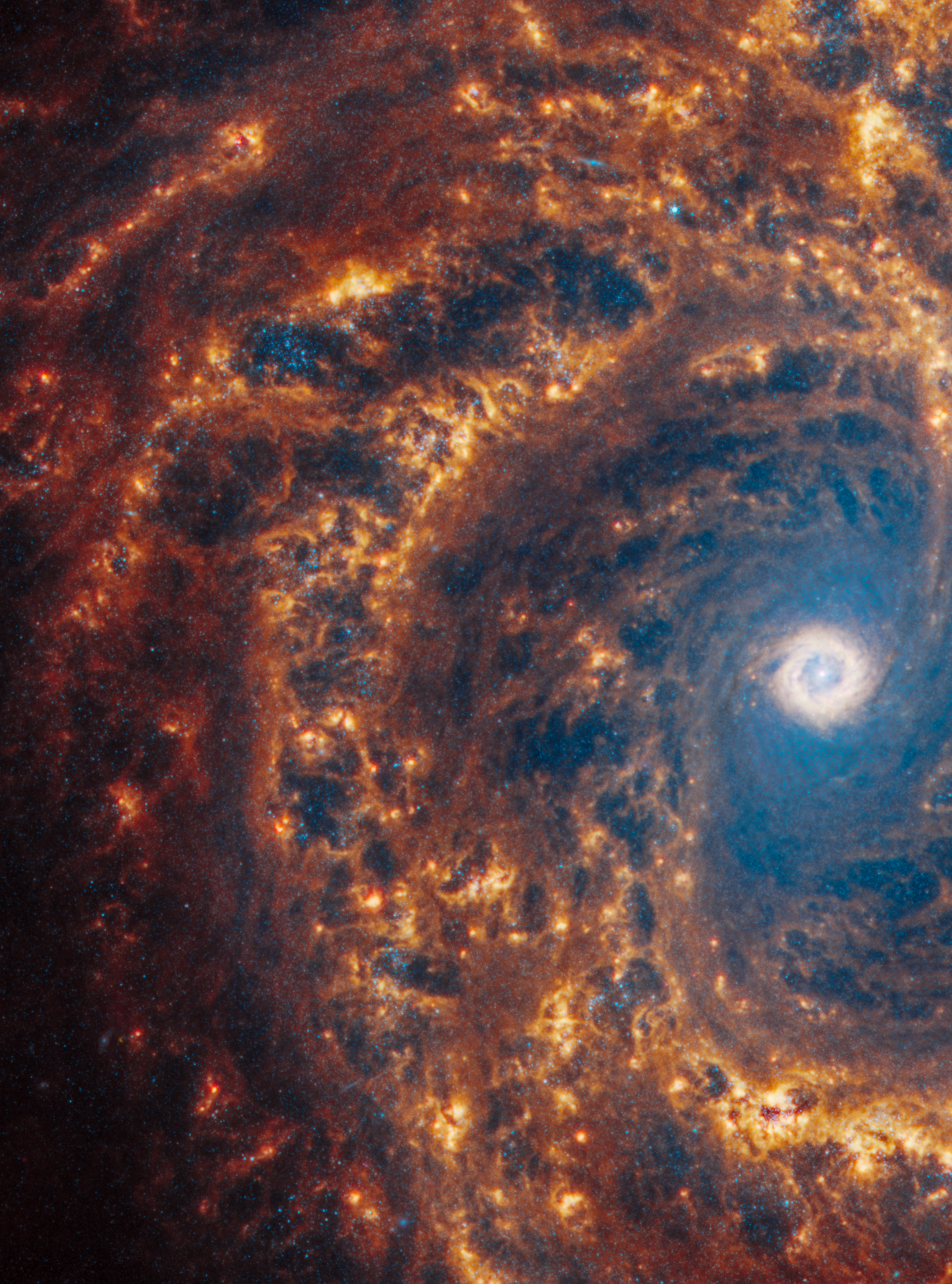
Webb and Hubble's Views of Spiral Galaxy NGC 4303
Face-on spiral galaxy, NGC 4303, is split diagonally in this image: The James Webb Space Telescope’s observations appear at top left, and the Hubble Space Telescope’s on bottom right. Webb and Hubble’s images show a striking contrast, an inverse of darkness and light. Why?...
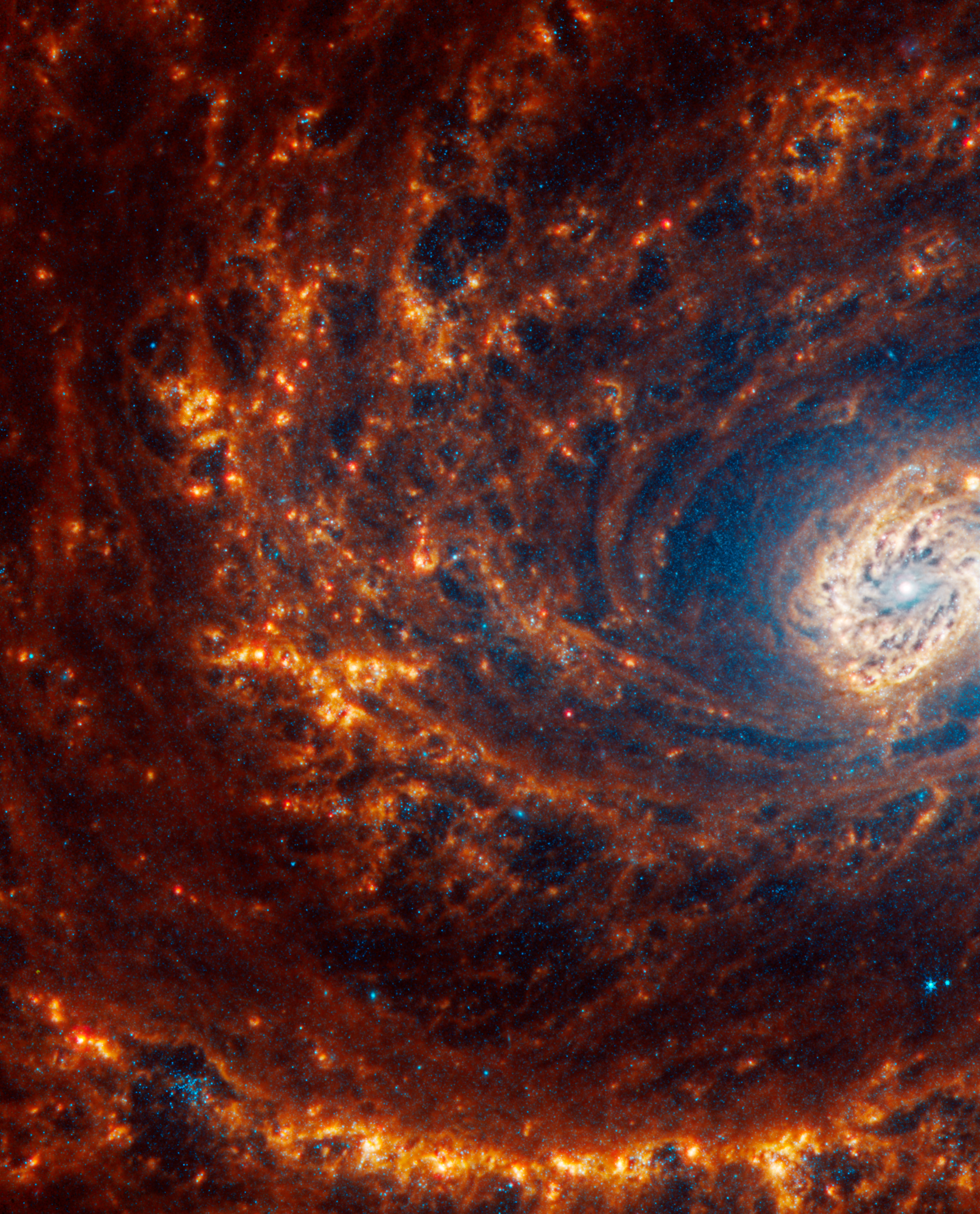
Webb and Hubble's Views of Spiral Galaxy NGC 4321
Face-on spiral galaxy, NGC 4321, is split diagonally in this image: The James Webb Space Telescope’s observations appear at bottom left, and the Hubble Space Telescope’s on top right. Webb and Hubble’s images show a striking contrast, an inverse of darkness and light. Why?...
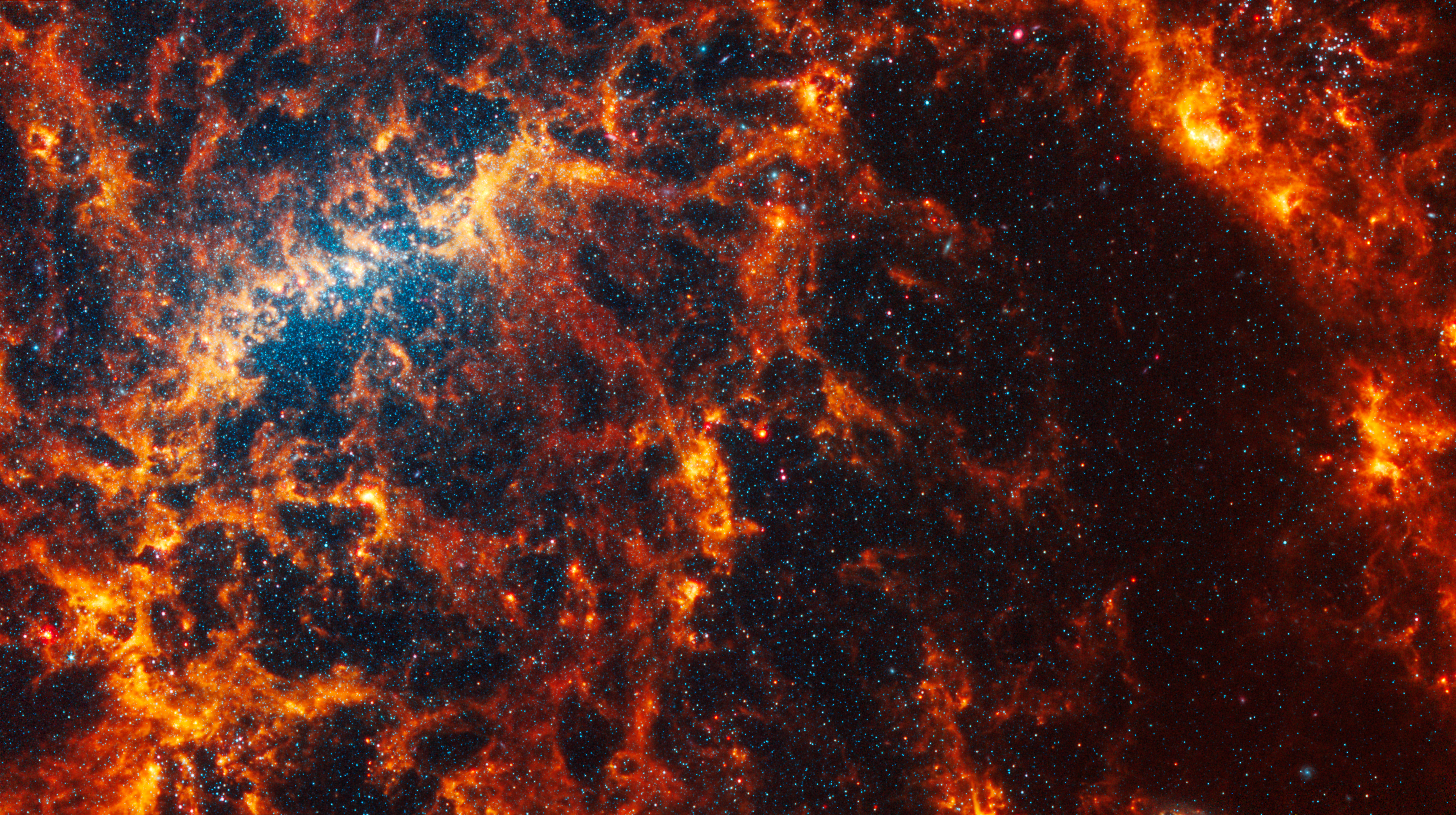
Webb and Hubble's Views of Spiral Galaxy NGC 5068
Face-on spiral galaxy, NGC 5068, is split diagonally in this image: The James Webb Space Telescope’s observations appear on bottom right, and the Hubble Space Telescope’s at top left. Webb and Hubble’s images show a striking contrast, an inverse of darkness and light. Why?...
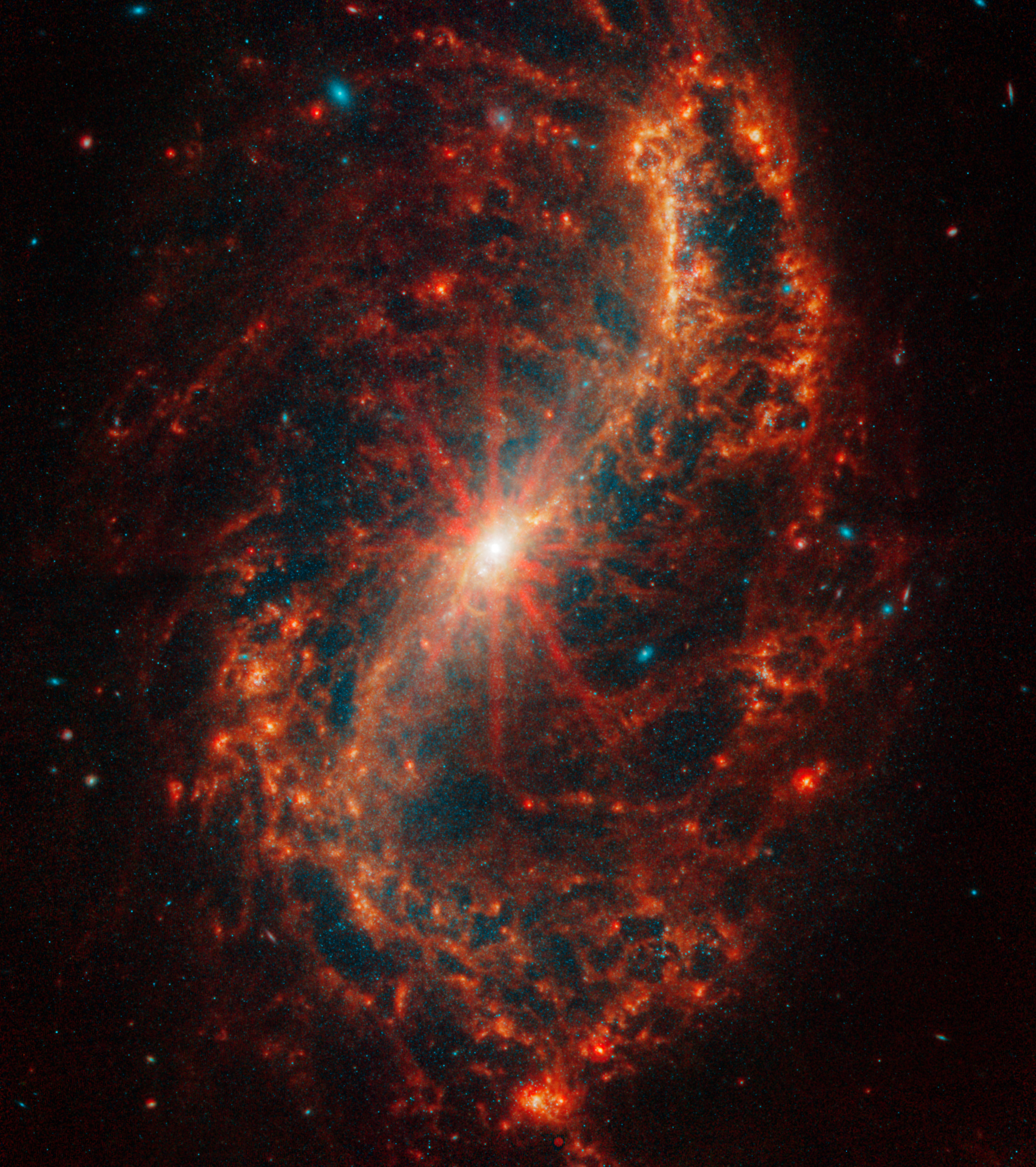
Webb and Hubble's Views of Spiral Galaxy NGC 7496
Face-on spiral galaxy, NGC 7496, is split diagonally in this image: The James Webb Space Telescope’s observations appear on bottom right, and the Hubble Space Telescope’s at top left. Webb and Hubble’s images show a striking contrast, an inverse of darkness and light. Why?...
Share
Details
Laura Betz
NASA’s Goddard Space Flight Center
Greenbelt, Maryland
laura.e.betz@nasa.gov
NASA, ESA, CSA, STScI, PHANGS Team, Janice Lee (STScI), Thomas Williams (Oxford)

